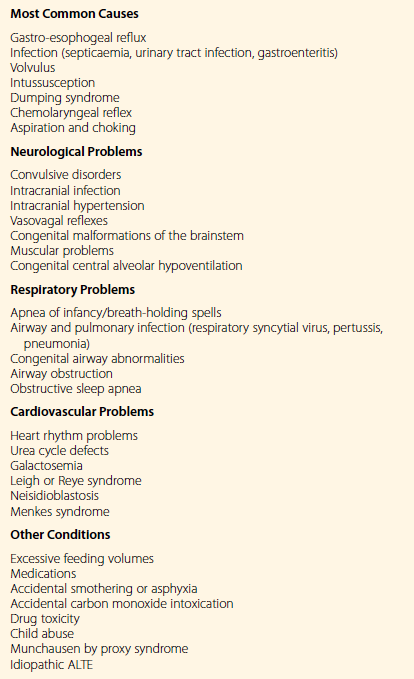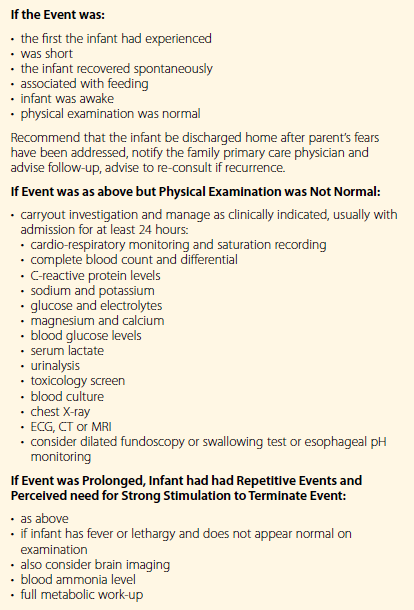Apparent Life Threatening Events (ALTE)
Definition of Apparent Life-Threatening Events (ALTE)
In the 1970s, it was thought that apparent life-threatening events (ALTE) were precursors to the sudden infant death syndrome (SIDS). These events, which were characterized by an acute and unexpected change in behavior with or without witnessed apnea, were referred to as near-miss for SIDS events.1 In 1987, an expert panel sponsored by the National Institutes of Health developed the now widely accepted definition of ALTE as ‘an episode that is frightening to the observer and that is characterized by some combination of apnea (central or occasionally obstructive), color change (usually cyanotic, but occasionally erythematous or plethoric), marked change in muscle tone (usually marked limpness), choking, or gagging.’2 The term ALTE has been adopted to replace the term near-miss for SIDS as no substantial evidence has been found to link the two conditions.2 During the 1980s and 1990s, numerous studies were carried out investigating infants who presented with ALTE to try to identify causes and risk factors for SIDS; however, a link between the two has never been proven and there is substantial evidence that the two conditions are, in fact, not related.
Relationship between ALTE and SIDS
There is no evidence that ALTE is a precursor to SIDS.2,3 This lack of association is evidenced by a number of findings including the temporal occurrence of the two events. SIDS invariably occurs during sleep and this finding has been included in the recent definition of the event.4 An ALTE can occur during sleep, when awake or during feeding,5 and in contrast to SIDS, most ALTE have been reported to occur during the daytime6–8 and whilst awake.9 In most cases, observers of an infant experiencing an ALTE report that the event appeared life-threatening or that they thought that the infant had died, but that prompt intervention resulted in normalization of the child’s appearance.5
This lack of association is further supported by the evidence that SIDS incidence has significantly decreased since the early 1990s in Western countries where campaigns to reduce the risks were introduced, while the incidence of ALTE has remained unchanged.10 In a study of 153 cases of ALTE that were enrolled in the Collaborative Home Infant Monitoring Evaluation (CHIME) between 1994 and 1998 it was reported that ALTE infants differed significantly from SIDS infants in four respects.8 Fewer ALTE infants (9%) were small for gestational age at birth compared with 19% of SIDS infants,11 fewer ALTE infants (19 %) were born to teenage mothers and this distribution was similar to the general population compared to 25% of SIDS mothers,11 and ALTE infants were of a younger age, 74% under 2 months of age compared to 27%12 and 24%.13 SIDS and ALTE infants had similar rates of prematurity (≈20%) and exposure to maternal smoking (ALTE infants 36%8 and SIDS infants 30–66%).11–15 One estimate has suggested that 7% of SIDS cases are preceded by ALTE;2 however, in the CHIME study only 1 of 153 ALTE infants subsequently died8 and in a review of 8 studies and 643 infants 5 deaths (0.8%) were reported, with all infants having an underlying medical problem.16
Although ALTE is not a precursor to SIDS, one study found that the SIDS rate for infants with ALTE was 10% and in those infants who had experienced multiple ALTE it rose to 28%.17 The two entities do, however, share some common risk factors. In a study of 244 SIDS cases and 868 SIDS controls, the incidence of ALTE was 1.9% in SIDS controls compared to 7.4% in the infants who subsequently died of SIDS.18 Furthermore, 33.3% of infants with ALTE who subsequently died from SIDS where exposed to both prenatal smoking and the prone sleeping position compared to 13% of ALTE survivors.18 The study suggested that there may be a subpopulation of ALTE infants who do not go on to die from SIDS because they were sleeping supine and not exposed to maternal smoking. In a recent study of 35 ALTE infants and 19 healthy control infants who underwent overnight polysomnography at 2–3 months, 5–6 months and 8–9 months of age, arousal characteristics were examined.19 All infants were born at term and were usual supine sleepers, and 18 of the ALTE infants had mothers who smoked. During non-rapid eye movement (NREM) sleep the ALTE infants had fewer total spontaneous arousals, cortical arousals and subcortical activations at both 2–3 and 5–6 months of age than control infants. ALTE infants with mothers who smoked had more obstructive apneas and more subcortical activations during rapid eye movement (REM) sleep. The same authors had previously reported that infants who subsequently died from SIDS had fewer cortical arousals and more subcortical activations, especially during REM sleep;20 thus, they concluded that ALTE and SIDS victims had distinctly different arousal characteristics. In contrast, another polysomnographic study of 26 ALTE infants and 36 age-matched control infants studied at 3 months of age found that ALTE infants exhibited enhanced arousal mechanisms and increased NREM sleep discontinuity compared to controls.21 Furthermore, normal infants showed a significant increase in cyclic alternating pattern (CAP) rate and a decrease in arousal index with age, while the ALTE infants showed no such correlation. The differences between the studies may have been due to the much lower incidence of maternal smoking (1/26) and the higher frequency of respiratory events (obstructive sleep apnea and periodic breathing) in the Miano et al. study.21 Despite these differences, both studies identified that ALTE infants demonstrated an immaturity of sleep EEG patterns that was most marked in NREM sleep, and both showed significant differences in arousal patterns from previous studies of SIDS infants.
The Incidence of ALTE
The incidence of ALTE has been estimated to be between 0.6 and 2.46 per 1000 live births.10,22,23 ALTE account for 0.6% to 1.7% of all emergency department visits of patients less than 1 year of age22–24 and 2.3% of pediatric hospitalizations in the USA.25 The majority of ALTEs occur in infants younger than 1 year of age, with a median age of 1–3 months16,26,27 and prematurely born infants are at increased risk.28
Causes of ALTE
Over 80% of infants with ALTE appear to have no acute distress when they are seen at the emergency department29 and no specific diagnosis can be found in up to 30% of those infants seen.26 The common causes of ALTE are listed in Table 25.1.
Table 25.1

Adapted from Kahn A. Recommended clinical evaluation of infants with an apparent life-threatening event. Consensus document of the European Society for the Study and Prevention of Infant Death, 2003. Eur J Pediatr. 2004;163(2):108–115; Fu LY, Moon RY. Apparent life-threatening events: an update. Pediatr Rev. 2012;33(8):361–368; quiz 368–369 and Samuels MP. Apparent Life-Threatening Events: Pathogenesis and Management. In: C.L Marcus JLC, D.F. Donnelly, G.M. Loughlin, editor. Sleep and Breathing in Children. Second ed. New York: Informa Healthcare; 2008. p. 229–254.
In a systematic review of 23 publications with 20 different cohorts from 9 different countries and a total of 6849 infants presenting with ALTE, 3.2% of infants were diagnosed with a serious bacterial infection, 5.0% with seizures, 0.4% as child abuse and 0.3% with a metabolic disorder.30 In another systematic review of eight non-randomized descriptive studies22,23,31–35 the most common diagnoses were gastro-esophageal reflux disease (GERD), which was reported in all studies and comprised 31% of total diagnoses, lower respiratory tract infection (LRTI) including ‘pertussis’ and ‘respiratory syncytial virus infection’ were reported in 5 studies and 8% of all diagnoses, and seizure was reported in 7 studies and 11% of diagnoses.16 Other diagnoses were problems with ear, nose and throat (3.6% of all diagnoses), cardiac problems (0.8%), urinary tract infection (1.1%), metabolic disease (1.5%), ingestion of drugs or toxins (1.5%), breath holding (2.3%), and factitious illness (0.3%). Only five ALTE episodes (0.7%) were completely benign. Unknown diagnoses were reported in 7/8 studies and made up 23% of all diagnoses, and this varied widely from 9% to 83% between studies.16
When investigating the underlying causes of ALTE, child abuse should also be considered, as studies have reported figures of up to 11%,36 although other studies have reported the incidence to be around 2%.37,38 In a study of infants diagnosed with abusive head trauma, over 30% of infants had been seen in the previous 3 weeks for other complaints including ALTE.39
Risk Factors for ALTE
Studies have consistently identified a number of risk factors for ALTE. ALTE typically affects infants under the age of 1 year and usually under 10 weeks of age, and there is a predisposition for more male infants to be affected.40 Premature infants are at twice the risk, with a national survey in the Netherlands reporting that 29.5% of ALTE infants were born preterm compared with 13% being born preterm in the general population.41 In a study of 625 infants admitted to Montreal Children’s Hospital between 1996 and 2006 for ALTE a similar proportion of 21% were born preterm.24 Furthermore, the relative risk of having an extreme event (either a central apnea lasting >30 s or an extreme bradycardia HR <60 bpm for 10 s) in infants <44 weeks post conceptional age (PCA) and HR <50 bpm for 10s in infants ≥44 weeks PCA whilst on a cardio-respiratory monitor was 6.3 (95% CI 3.6–11.0) for preterm born infants. Other risk factors include exposure to second-hand cigarette smoke, exposure to pertussis, respiratory syncytial virus or recent general anesthesia.16,22,42
ALTE in the First 24 Hours after Birth
Recently, there have been reports of infants with ALTE within the first day of life. A nationwide retrospective German study reported a rate of 2.6 per 100 000 live births of severe ALTE requiring resuscitation and SIDS in the first 24 hours after birth.43 Of the 17 infants who met the inclusion criteria 7 infants died; 3 after unsuccessful resuscitation and 4 had initially been resuscitated but had treatment discontinued because of severe hypoxic brain damage. Of the 10 survivors, 6 were neurologically abnormal on discharge. Twelve infants were found lifeless, lying on their mother’s breast/abdomen or very close to and facing her, two were supine in their cots, two were being held by their fathers and one was lying supine next to their mother. Among the 26 cases excluded from the analysis, 4 were preterm but otherwise met the inclusion criteria. A further 3 infants were resuscitated with vigorous stimulation only. Another study published in the same year reports 6 cases of healthy term newborns (all with Apgar scores of 10 at both 5 and 10 minutes) who suffered an ALTE within 2 hours of delivery whilst in skin-to-skin contact with their mother; 3 of 6 infants died.44 A prospective French regional study reported a rate of ALTE and SIDS of 0.032 deaths per 1000 live births within the first 2 hours after birth.45 These studies highlight that there are risks associated with early skin-to-skin contact or breast feeding, especially when infants are not being closely observed by healthcare professionals.
Initial Assessment for ALTE
In a consensus statement from the European Society for the Study and Prevention of Infant Death in 2004 it was concluded that, ‘There was no standard minimal workup in the evaluation of ALTE.’5 The assessment of an infant who presents with an ALTE has been well reviewed in the literature recently.5,9,30,46–49 A number of protocols for the initial examination have been published.5,9,30,46,49–51 Details of the recommendations for the initial assessment are provided in Table 25.2.
Table 25.2
Recommendations for Initial Assessment

Adapted from McGovern MC, Smith MB. Causes of apparent life threatening events in infants: a systematic review. Arch Dis Child. 2004;89(11):1043–1048 and Al Khushi N, Cote A. Apparent life-threatening events: assessment, risks, reality. Paediatr Respir Rev. 2011;12(2):124–132
Stay updated, free articles. Join our Telegram channel

Full access? Get Clinical Tree


